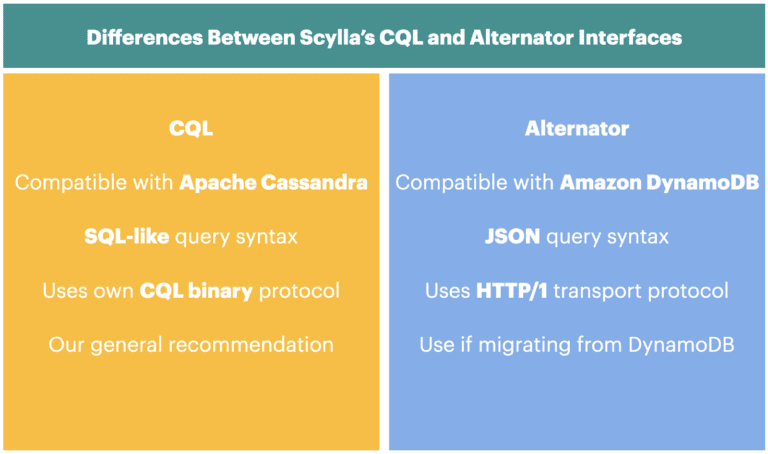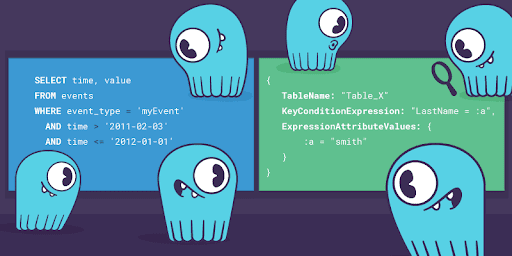Amazon DynamoDB came out in 2012, two years after Cassandra. DynamoDB’s data model was inspired by Cassandra’s. In both DynamoDB and Cassandra, database rows are grouped together in a partition by a partition key, with the rows inside the partition sorted by a clustering key. The DynamoDB API and CQL use different names for these same concepts, though:
| | CQL term | DynamoDB term |
| Smallest addressable content | row | item |
| Sub-entities | column | attribute |
| Unit of distribution | partition (many rows) | partition (many items) |
| Key for distribution | partition key | partition key (also hash key) |
| Key within partition | clustering key | sort key (also range key) |
Despite this basic similarity in how the data is organized — and therefore in how data can be efficiently retrieved — there is a significant difference in how DynamoDB and CQL model writes. The two APIs offer different write primitives and make different guarantees on the performance of these primitives:
Cassandra is optimized for write performance. Importantly, ordinary writes do not require a read of the old item before the write: A write just records the change, and only read operations (and background operations known as compaction and repair) will later reconcile the final state of the row. This approach, known as Conflict-free Replicated Data Types (CRDT), has implications on Cassandra’s implementation, including its data replication and its on-disk storage in a set of immutable files called sstables (comprising an LSM). But more importantly for this post, the wish that ordinary writes should not read also shaped Cassandra’s API, CQL:
- Ordinary write operations in CQL — both UPDATE and INSERT requests — just set the value of some columns in a given row. These operations cannot check whether the row already existed beforehand, and the new values cannot depend on the old values. A write cannot return the old pre-modification values, nor can it return the entire row when just a part of it was modified.
- These ordinary writes are not always serialized. They usually are: CQL assigns a timestamp (with microsecond resolution) to each write and the latest timestamp wins. However two concurrent writes which happen to receive exactly the same timestamp may get mixed up, with values from both writes being present in the result.
For more information on this problem, see this Jepsen post. - CQL offers a small set of additional CRDT data structures for which writes just record the change and do not need to involve a read of the prior value. These include collections (maps, sets and lists) and counters.
- Additionally, CQL offers special write operations that do need to read a row’s previous state before a write. These include materialized views and lightweight transactions (LWT). However, these write operations are special; Users know that they are significantly slower than ordinary writes because they involve additional synchronization mechanisms – so users use them with forethought, and often sparingly.
Contrasting with CQL’s approach, DynamoDB’s approach is that every write starts with a read of the old value of the item. In other words, every write is a read-modify-write operation. Again, this decision had implications on how DynamoDB was implemented. DynamoDB uses leader-based replication so that a single node (the leader for the item) can know the most recent value of an item and serialize write operations on it. DynamoDB stores data on disk using B-trees which allow reads together with writes. But again, for the purpose of this post, the interesting question is how making every write a read-modify-write operation shaped DynamoDB’s API:
- In the DynamoDB API, every write operation can be conditional: A condition expression can be added to a write operation, and uses the previous value of the item to determine whether the write should occur.
- Every write operation can return the full content of the item before the write (ReturnValues).
- In some update operations (UpdateItem), the new value of the item may be based on the previous value and an update expression. For example, “a = a + 1” can increment the attribute a (there isn’t a need for a special “counter” type as in CQL).
- The value of an item attribute may be a nested JSON-like type, and an update may modify only parts of this nested structure. DynamoDB can do this by reading the old nested structure, modifying it, and finally writing the structure back.
CQL could have supported this ability as well without read-modify-write by adding a CRDT implementation of a nested JSON-like structure (see, for example, this paper) — but currently doesn’t and only supports single-level collections. - Since all writes involve a read of the prior value anyway, DynamoDB charges for writes the same amount whether or not they use any of the above features (condition, returnvalues, update expression). Therefore users do not need to use these features sparingly.
- All writes are isolated from each other; two concurrent writes to the same row will be serialized.
This comparison demonstrates that the write features that the DynamoDB and CQL APIs provide are actually very similar: Much of what DynamoDB can do with its various read-modify-write operations can be done in CQL with the lightweight transactions (LWT) feature or by simple extensions of it. In fact, this is what ScyllaDB does internally: We implemented CQL’s LWT feature first, and then used the same implementation for the write operations of the DynamoDB API.
However, despite the similar write features, the two APIs are very different in their performance characteristics:
- CQL makes an official distinction between write-only updates and read-modify-write updates (LWT), and the two types of writes must not be done concurrently to the same row. This allows a CQL implementation to implement write-only updates more efficiently than read-modify-write updates.
- A DynamoDB API implementation, on the other hand, cannot do this optimization: With the DynamoDB API, write-only updates and (for example) conditional updates can be freely mixed and need to be isolated from one another.
This requirement has led ScyllaDB’s implementation of the DynamoDB API to use the heavyweight (Paxos-based) LWT mechanism for every write, even simple ones that do not require reads, making them significantly slower than the same write performed via the CQL API. We will likely optimize this implementation in the future, perhaps by adopting a leader model (like DynamoDB), but an important observation is that in every implementation of the DynamoDB API, writes will be significantly more expensive than reads. Amazon prices write operations at least 5 times more expensive than reads (this ratio reaches 40 for weakly-consistent reads of 4 KB items).
Amazon prices a write unit (WCU) at 5 times the cost of a read unit (RCU). Additionally, for large items, each 1 KB is counted as a write unit, while a read unit is 4 KB. Moreover, eventually-consistent reads are counted as half a read unit. So writing a large item is 40 (=5*4*2) times more expensive than reading it with an eventually-consistent read.
ScyllaDB provides users with an option to do DynamoDB-API write-only updates (updates without a condition, update expression, etc.) efficiently, without LWT. However, this option is not officially part of the DynamoDB API, and as explained above — cannot be made safe without adding an assumption that write-only updates and read-modify-write updates to the same item cannot be mixed.


 Looking for extensive training on data modeling, database migration, and high performance for NoSQL Databases? Our experts offer 3-hour masterclasses that assists practitioners wanting to migrate from SQL to NoSQL or advance their understanding of NoSQL data modeling. This free, self-paced class covers techniques and best practices on these NoSQL concepts that will help you steer clear of mistakes that could inconvenience any engineering team.
Looking for extensive training on data modeling, database migration, and high performance for NoSQL Databases? Our experts offer 3-hour masterclasses that assists practitioners wanting to migrate from SQL to NoSQL or advance their understanding of NoSQL data modeling. This free, self-paced class covers techniques and best practices on these NoSQL concepts that will help you steer clear of mistakes that could inconvenience any engineering team.